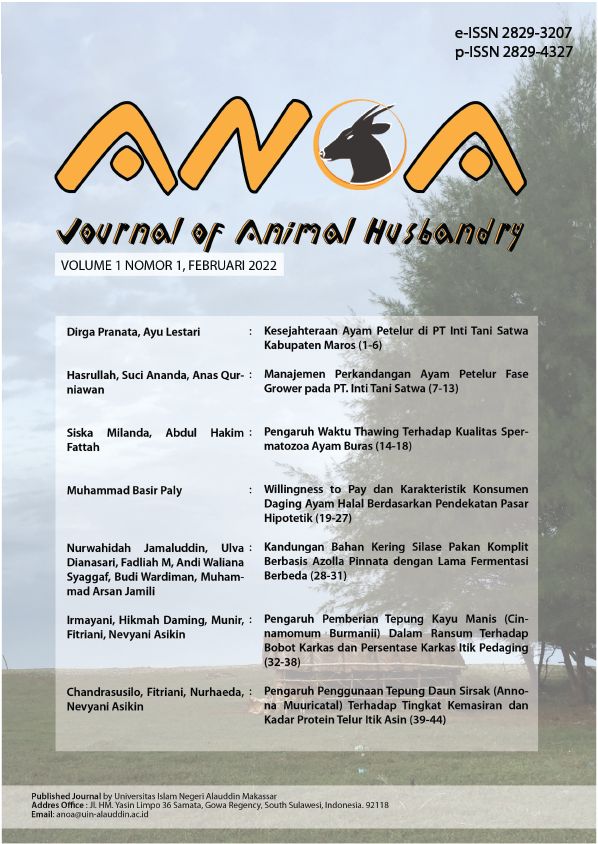Kesejahteraan Ayam Petelur di PT Inti Tani Satwa Kabupaten Maros
Welfare of Layer (Case Study: PT. ITS, Maros Regency, South Sulawesi)
Abstract
Animal welfare relates to physical and mental states that conform to the natural behavior of animals and need to be implemented to protect animals. Laying hens are very vulnerable to violating animal welfare principles because of high production targets but demands to minimize costs. The study was conducted in the laying hens of the grower phase of PT. ITS with direct observations, interviews, and discussions. The results were analyzed descriptively according to five principles of animal welfare, namely freedom from pain, injury, and disease, freedom from hunger and thirst, freedom from heat and discomfort, freedom from fear and suffering, and freedom to express normal and natural behavior. The results show that the implementation of animal welfare at PT. ITS has been carried out, but there are also aspects that are not fulfilled, namely the aspect of being free to express normal and natural behavior that has not been fully implemented because the density of the rang or cage makes the animals very crowded so this must be corrected so that the livestock welfare aspects can be met.
Downloads
References
Gustira D.E., Riyanti, & Kurtini, T. (2015). Pengaruh kepadatan kandang terhadap performa produksi ayam petelur fase awal grower. Jurnal Ilmiah Peternakan Terpadu, 3(1): 87-92.
Hincke, M.T., Nys, Y., Gautron, J., Mann, K., Navarro, A.B.R., & Mc. Kee, M.D. (2012). The eggshell: structure, composition and mineralization. Frontiers in Bioscience (17): 1266-1280.
Priyatno. (2004). Membuat kandang ayam. Cetakan ke-8. Jakarta: Penebar Swadaya.
Rahadi, S. (2012). Manajemen peternakan ayam petelur. Malang: CV Diaspora Publisher.
Setiawati, T., Afnan, R., Ulupi, N. (2016). Performa produksi dan kualitas telur ayam petelur pada sistem litter dan cage dengan suhu kandang berbeda. Jurnal Ilmu Produksi dan Teknologi Hasil Peternakan, 4(1): 197-203.
Sugiharto, P.D.S. (2015). Kesejahteraan dan metode penelitian tingkah laku unggas. Semarang: Badan Penerbit Universitas Diponegoro.
Susanti, Hidayati, N.A., Afriyansyah, B. (2015). Penerapan kesejahteraan hewan pada beberapa peternakan ayam ras pedaging (studi kasus di kabupaten bangka). Ekotonia, 2 (1): 49-57. https://doi.org/10.33019/ekotonia.v2i1.468.
Thaha, A.H., Halim, I.N., Mappanganro, R., Syam, J., & Suarda, A. (2021). Evaluasi penerapan kesejahteraan hewan pada tempat pemotongan unggas di Kabupaten Takalar, Provinsi Sulawesi Selatan. Jurnal Ilmu dan Industri Peternakan, 7 (1): 81-91. DOI: https://doi.org/10.24252/jiip.v7v1.20335.
Winarso, A. (2008). Kajian kesejahteraan hewan ternak dalam ajaran agama Buddha, Hindu, Yahudi, Nasrani, dan Islam. [Skripsi, Institut Pertanian Bogor].Fakultas Kedokteran Hewan Institut Pertanian Bogor.
Yupi. (2011). Analisis usaha tani ayam ras petelur. [Skripsi, Universitas Islam Negeri Syarif Hidayatullah]. Fakultas Sains dan Teknologi UIN Syarif Hidayatullah.


